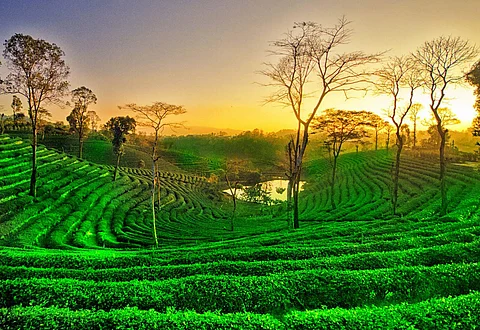
- Home
- Live Blog
- Breaking News
- Top Headlines
- Cities
- NE News
- Sentinel Media
- Sports
- Education
- Jobs

Pulin Deka
(pulindeka1967@gmail.com)
In the current globalised world of the twenty-first century, science and technology have brought about rapid change of social norms and values, simultaneously raising questions about how to integrate heritage conservation, sustainable development, and the promotion of conservation in line with achieving economic and social sustainability in the modern age. Culture and civilisation have always played a decisive role in shaping our collective identity, enhancing the understanding of the past, and influencing our future. Cultural heritage has an outstanding universal value from the historical, architectural, commemorative, aesthetic, ethnological, or anthropological perspectives. The cultural and spiritual heritage that has inspired people since ancient times has the power to transcend current geopolitical factors and offer solutions for a better world. It also contributed towards the uniqueness of the national identity, which needs to be passed among future generations. The relationship between tradition and modernity is interrelated, as it not only defines every level of a nation’s development but also fosters an environment that organises the nation’s thought amongst the people. Modernity, when combined with technological advancement, fosters a competitive mindset and social change in the era of globalisation. Heritage provides a momentum for a nation to move forward with dignity, social order, artistic sensibility, and self-confidence, and it has a far-reaching impact on conforming national character while also keeping alive the continuous gush of cultural consciousness. The level of development that emerged in Europe as a result of industrialization during the 19th and 20th centuries gave modernity a new dimension. Along with this developed a mindset that recognised modern heritage as a significant aspect of culture. Thousands of years of civilisation and culture have endowed humanity with an inexhaustible strength; hence, heritage treasures are precious communal assets that show the past human legacy. It depicts present and future ways of life as well as cultural values of a society and enhances solidarity and social integration of communities. Traditional folk art festivals and customs are a source of inspiration for any community. It has contributed significantly to bringing national identity, bridging the past with the present, and fostering a sense of continuity and belonging. Tradition, when expressed through heritage and artistic expressions, has the power to influence modern lifestyles. That is why tradition and culture are considered the lifeline of a nation.
With the new heritage that modern technology has unleashed comes a message of prosperity. Among its features, the integration of technology with socio-economic development is a key factor that has led the younger generation to prioritise it. In the digital realm they explore, they strive to shape a future-orientated mindset and ensure personal growth. At the same time, guiding the younger generation to uphold traditional and cultural consciousness with sustainable development while clearly defining their social identity has become a crucial call of the present era. Heritage represents cultural values, beliefs, and practices passed down across generations. Modernity embodies change, innovation, and progress. Just as modern technology has brought about astonishing transformations in social life, tradition too carries the profound legacy of ancient civilisations. However, the gesture required to create a new effort to establish the connection between tradition and modernity has yet to emerge. Since tradition and modernity are interrelated concepts, both play a significant role in the evolution and transformation of society. From the latter half of the 20th century, in our country, tradition and modernity have stoodas two distinct streams. Modernity has significantly blurred the traditional social fabric and values. In a culturally rich country like India, there is a need to evaluate history and pursue modern aspirations in a parallel manner, which requires a transformation in people’s mindset. Understanding the true essence of modernity demands greater effort, and to achieve this, both social organizations and the government must work together through a collaborative approach. In our country, the younger generation is striving to move forward guided by three ideologies—regionalism, nationalism, and internationalism. In such a context, the fusion of modernity and tradition becomes a complex issue, and making it universally acceptable requires further research. Traditions of various indigenous communities have invigorated our civic life and glorified the uniqueness. Since Prime Minister Narendra Modi came to power, his efforts to advance modernity in a parallel way have ushered in a new awakening across India. Through continuous efforts to foster a new environment that leads the new generation forward through science and technology while building a value-based life rooted in tradition, today’s youth are not only progressing in terms of technology but are also finding a path to develop a sense of responsibility towards India’s five-thousand-year-old civilisation and culture.
Assam today has embarked on a new journey that harmonises modernity with tradition. In the last four years, Chief Minister Dr. Himanta Biswa Sarma has accelerated Assam’s developmental process by making transformations through science and technology. Assam has touched new dimensions of modern development while also taking unprecedented steps for the conservation of heritage. The government of Assam has been taking all measures and actions aimed at safeguarding heritage while ensuring its accessibility to present and future generations through various initiatives, including tourism policies and community engagement programs. Today, the new generation is eager to walk the path of modernity, and different groups are seeking to reconnect with their heritage. To preserve heritage and connect younger generations with their roots, the present state government has also implemented schemes like financial assistance to revive Xatras and Namghars, liberating encroached Xatra land, UNESCO recognition of Charaideo as a world heritage site, preservation and enhancement of Rong Ghar, promoting the spiritual beliefs of all ethnic groups, honouring Lachit Barphukan at the national level, naming flyovers in connection with heritage, taking Bihu and Jhumur to the international stage, and paving the way for a new direction. These initiatives provide the new generation an opportunity to learn about their glorious heritage.